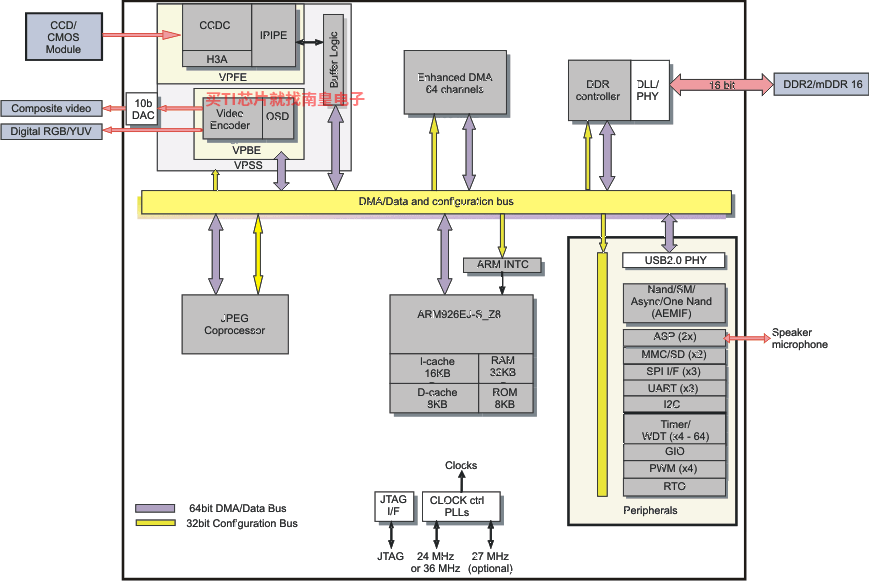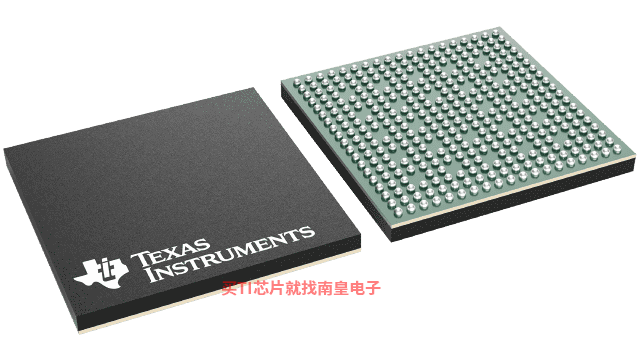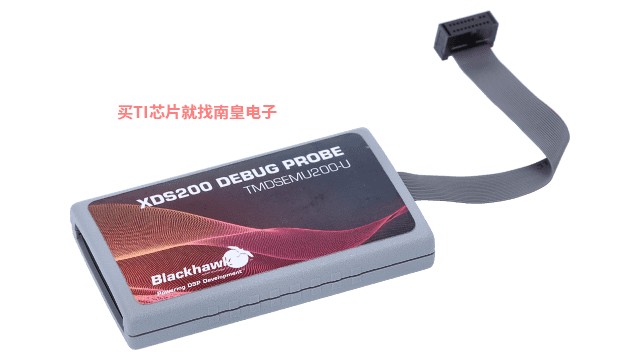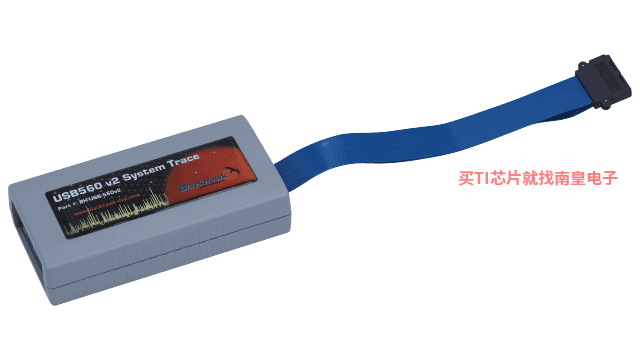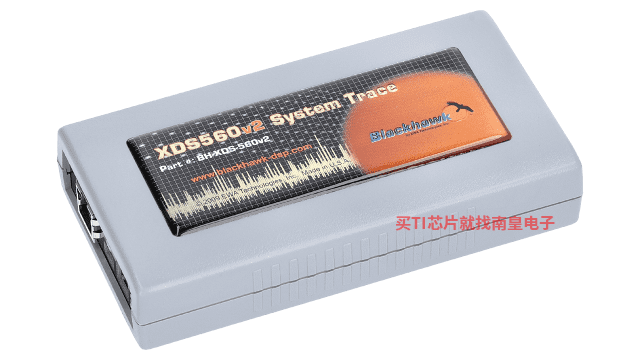
- 制造厂商:TI
- 产品类别:微控制器 (MCU) 和处理器
- 技术类目:处理器 - 数字信号处理器 (DSP)
- 功能描述:数字媒体片上系统 (DMSoC)
- 点击这里打开及下载TMS320DM335的技术文档资料
- TI代理渠道,提供当日发货、严格的质量标准,满足您的目标价格

The DM335 processor is a low-cost, low-power processor providing advanced graphical user interface for display applications that do not require video compression and decompression. Coupled with a video processing subsystem (VPSS) that provides 720p display, the DM335 processor is powered by a 135/216-MHz ARM926EJ-S core so developers can create feature-rich graphical user interfaces allowing customers to interact with their portable, electronic devices such as video-enabled universal remote controls, Internet radio, e-books, video doorbells, and digital telescopes. The new DM335 is packed with the same peripherals as its predecessor, the TMS320DM355 device, including high-speed USB 2.0 on-the-go, external memory interface (EMIF), mobile DDR/DDR2, two SDIO ports, three UART Ports, two Audio Serial Ports, three SPI Ports, and SLC/MCL NAND Flash memory support. These peripherals help customers create DM335 processor-based designs that add video and audio excitement to a wide range of today's static user-interface applications while keeping silicon costs and power consumption low. The new digital media processor is completely scalable with the DM355 processor and Digital Video Evaluation Board (DVEVM), allowing customers to utilize their same code for their new DM335 processor focused designs.
The new DM335 device delivers a sophisticated suite of capabilities allowing for flexible image capture and display. Through its user interface technology, such as a four-level on-screen display, developers are able to create picture-within-picture and video-within-video as well as innovative graphic user interfaces. This is especially important for portable products that require the use of button or touch screen, such as portable karaoke, video surveillance and electronic gaming applications. Additional advanced capture and imaging technologies include support for CCD/CMOS image sensors, resize capability and video stabilization. The 1280-by-960-pixel digital LCD connection runs on a 75-MHz pixel clock and supports TV composite output for increased expandability. This highly integrated device is packaged in a 13 x 13 mm, 337 pin , 0.65 mm pitch BGA package.
The DM335 processor core is an ARM926EJ-S RISC processor. The ARM926EJ-S is a 32-bit processor core that performs 32-bit and 16-bit instructions and processes 32-bit, 16-bit, and 8-bit data. The core uses pipelining so that all parts of the processor and memory system can operate continuously. The ARM core incorporates:
- A coprocessor 15 (CP15) and protection module
- Data and program Memory Management Units (MMUs) with table look-aside buffers.
- Separate 16K-byte instruction and 8K-byte data caches. Both are four-way associative with virtual index virtual tag (VIVT).
The DM335 device has a Video Processing Subsystem (VPSS) with two configurable video/imaging peripherals:
- A Video Processing Front-End (VPFE)
- A Video Processing Back-End (VPBE)
The VPFE port provides an interface for CCD/CMOS imager modules and video decoders. The VPBE provides hardware On Screen Display (OSD) support and composite NTSC/PAL and digital LCD output.
The DM335 peripheral set includes:
- An inter-integrated circuit (I2C) Bus interface
- Two audio serial ports (ASP)
- Three 64-bit general-purpose timers each configurable as two independent 32-bit timers
- A 64-bit watchdog timer
- Up to 104-pins of general-purpose input/output (GPIO) with programmable interrupt/event generation modes, multiplexed with other peripherals
- Three UARTs with hardware handshaking support on one UART
- Three serial port Interfaces (SPI)
- Four pulse width modulator (PWM) peripherals
- Four real time out (RTO) outputs
- Two Multi-Media Card / Secure Digital (MMC/SD/SDIO) interfaces
- Wireless interfaces (Bluetooth, WLAN, WUSB) through SDIO
- A USB 2.0 full and high-speed device and host interface
- Two external memory interfaces:
- An asynchronous external memory interface (AEMIF) for slower memories/peripherals such as NAND and OneNAND,
- A high speed synchronous memory interface for DDR2/mDDR.
For software development support the DM335 has a complete set of ARM development tools which include: C compilers, assembly optimizers to simplify programming and scheduling, and a Windows™debugger interface for visibility into source code execution.
- Highlights
- High-Performance Digital Media System-On-Chip (DMSoC)
- Up to 216-MHz ARM926EJ-STM Clock Rate
- Digital HDTV (720p/1080i) output for connection to external encoder
- Video Processing Subsystem
- Hardware IPIPE for Real-Time Image Processing
- Up to 14-bit CCD/CMOS Digital Interface
- Histogram Module
- Resize Image 1/16x to 8x
- Hardware On-Screen Display
- Up to 75-MHz Pixel Clock
- Composite NTSC/PAL video encoder output
- Peripherals include DDR and mDDR SDRAM, 2 MMC/SD/SDIO and SmartMedia Flash Card Interfaces, USB 2.0, 3 UARTs and 3 SPIs
- Enhanced Direct-Memory-Access (EDMA)
- Configurable Power-Saving Modes
- On-Chip ARM ROM Bootloader (RBL) to Boot From NAND Flash, MMC/SD, or UART
- 3.3-V and 1.8-V I/O, 1.3-V Core
- Debug Interface Support
- Up to 104 General-Purpose I/O (GPIO) Pins
- 337-Pin Ball Grid Array at 65 nm Process Technology
- High-Performance Digital Media System-on-Chip
- 135-, 216-MHz ARM926EJ-S? Clock Rate
- Fully Software-Compatible With ARM?
- Extended Temperature 135- and 216-MHz Devices are Available
- ARM926EJ-S Core
- Support for 32-Bit and 16-Bit (Thumb Mode) Instruction Sets
- DSP Instruction Extensions and Single Cycle MAC
- ARM? Jazelle? Technology
- EmbeddedICE-RT? Logic for Real-Time Debug
- ARM9 Memory Architecture
- 16K-Byte Instruction Cache
- 8K-Byte Data Cache
- 32K-Byte RAM
- 8K-Byte ROM
- Little Endian
- Video Processing Subsystem
- Front End Provides:
- Hardware IPIPE for Real-Time Image Processing
- Up to 14-bit CCD/CMOS Digital Interface
- 16-/8-bit Generic YcBcR-4:2 Interface (BT.601)
- 10-/8-bit CCIR6565/BT655 Interface
- Up to 75-MHz Pixel Clock
- Histogram Module
- Resize Engine
- Resize Images From 1/16x to 8x
- Separate Horizontal/Vertical Control
- Two Simultaneous Output Paths
- Back End Provides:
- Hardware On-Screen Display (OSD)
- Composite NTSC/PAL video encoder output
- 8-/16-bit YCC and Up to 18-Bit RGB666 Digital Output
- BT.601/BT.656 Digital YCbCr 4:2:2 (8-/16-Bit) Interface
- Digital HDTV (720p/1080i)output for connection to external encoder
- Front End Provides:
- External Memory Interfaces (EMIFs)
- DDR2 and mDDR SDRAM 16-bit wide EMIF With 256 MByte Address Space (1.8-V I/O)
- Asynchronous16-/8-bit Wide EMIF (AEMIF)
- Flash Memory Interfaces
- NAND (8-/16-bit Wide Data)
- OneNAND(16-bit Wide Data)
- Flash Memory Interfaces
- Flash Card Interfaces
- Two Multimedia Card (MMC) / Secure Digital (SD/SDIO)
- SmartMedia
- Enhanced Direct-Memory-Access (EDMA) Controller (64 Independent Channels)
- USB Port with Integrated 2.0 High-Speed PHY that Supports
- USB 2.0 Full and High-Speed Device
- USB 2.0 Low, Full, and High-Speed Host
- Three 64-Bit General-Purpose Timers (each configurable as two 32-bit timers)
- One 64-Bit Watch Dog Timer
- Three UARTs (One fast UART with RTS and CTS Flow Control)
- Three Serial Port Interfaces (SPI) each with two Chip-Selects
- One Master/Slave Inter-Integrated Circuit (I2C) Bus?
- Two Audio Serial Port (ASP)
- I2S and TDM I2S
- AC97 Audio Codec Interface
- S/PDIF via Software
- Standard Voice Codec Interface (AIC12)
- SPI Protocol (Master Mode Only)
- Four Pulse Width Modulator (PWM) Outputs
- Four RTO (Real Time Out) Outputs
- Up to 104 General-Purpose I/O (GPIO) Pins (Multiplexed with Other Device Functions)
- On-Chip ARM ROM Bootloader (RBL) to Boot From NAND Flash, MMC/SD, or UART
- Configurable Power-Saving Modes
- Crystal or External Clock Input (typically 24 MHz or 36 MHz)
- Flexible PLL Clock Generators
- Debug Interface Support
- IEEE-1149.1 (JTAG) Boundary-Scan-Compatible
- ETB? (Embedded Trace Buffer?) with4K-Bytes Trace Buffer memory
- Device Revision ID Readable by ARM
- 337-Pin Ball Grid Array (BGA) Package (ZCE Suffix), 0.65-mm Ball Pitch
- 90nm Process Technology
- 3.3-V and 1.8-V I/O, 1.3-V Internal
- Community Resources
- TI E2E Community
- TI Embedded Processors Wiki
Windows is a trademark of Microsoft. All other trademarks are the property of their respective owners.
- Operating system
- Integrity, Linux, Neutrino, PrOS, Windows Embedded CE
- Rating
- Catalog
- Operating temperature range (C)
- 0 to 85
TMS320DM335的完整型号有:TMS320DM335DZCE216、TMS320DM335ZCE270,以下是这些产品的关键参数及官网采购报价:
TMS320DM335DZCE216,工作温度:0 to 85,封装:NFBGA (ZCE)-337,包装数量MPQ:160个,MSL 等级/回流焊峰值温度:Level-3-260C-168 HR,引脚镀层/焊球材料:SNAGCU,TI官网TMS320DM335DZCE216的批量USD价格:9.723(1000+)
TMS320DM335ZCE270,工作温度:0 to 85,封装:NFBGA (ZCE)-337,包装数量MPQ:160个,MSL 等级/回流焊峰值温度:Level-3-260C-168 HR,引脚镀层/焊球材料:Call TI,TI官网TMS320DM335ZCE270的批量USD价格:15.267(1000+)

TMDSEMU200-U — Spectrum Digital XDS200 USB 仿真器
Spectrum Digital XDS200 是最新 XDS200 系列 TI 处理器调试探针(仿真器)的首个模型。XDS200 系列拥有超低成本 XDS100 与高性能 XDS560v2 之间的低成本与高性能的完美平衡。此外,对于带有嵌入式缓冲跟踪器 (ETB) 的所有 ARM 和 DSP 处理器,所有 XDS 调试探针均支持内核和系统跟踪。
Spectrum Digital XDS200 通过 TI 20 引脚连接器(带有适合 TI 14 引脚、TI 10 引脚和 ARM 20 引脚的多个适配器)连接到目标板,而通过 USB2.0 高速连接 (480Mbps) 连接到主机 PC。要在主机 (...)
TMDSEMU560V2STM-U — Blackhawk XDS560v2 系统跟踪 USB 仿真器
XDS560v2 System Trace 是 XDS560v2 系列高性能 TI 处理器调试探针(仿真器)的第一种型号。XDS560v2 是 XDS 系列调试探针中性能最高的一款,同时支持传统 JTAG 标准 (IEEE1149.1) 和 cJTAG (IEEE1149.7)。
XDS560v2 System Trace 在其巨大的外部存储器缓冲区中加入了系统引脚跟踪。这种外部存储器缓冲区适用于指定的 TI 器件,通过捕获相关器件级信息,获得准确的总线性能活动和吞吐量,并对内核和外设进行电源管理。此外,对于带有嵌入式缓冲跟踪器 (ETB) 的所有 ARM 和 DSP 处理器,所有 XDS (...)
TMDSEMU560V2STM-UE — Spectrum Digital XDS560v2 系统跟踪 USB 和以太网
XDS560v2 System Trace 是 XDS560v2 系列高性能 TI 处理器调试探针(仿真器)的第一种型号。XDS560v2 是 XDS 系列调试探针中性能最高的一款,同时支持传统 JTAG 标准 (IEEE1149.1) 和 cJTAG (IEEE1149.7)。
XDS560v2 System Trace 在其巨大的外部存储器缓冲区中加入了系统引脚跟踪。这种外部存储器缓冲区适用于指定的 TI 器件,通过捕获相关器件级信息,获得准确的总线性能活动和吞吐量,并对内核和外设进行电源管理。此外,对于带有嵌入式缓冲跟踪器 (ETB) 的所有 ARM 和 DSP 处理器,所有 XDS (...)
LINUXDVSDK-DV — Linux 数字视频软件开发套件 (DVSDK) v2x/v3x - 达芬奇数字媒体处理器
2010 年 10 月生效 - Linux DVSDK v4 已发布。对于上面未列出的 DaVinci 器件,请在 TI.com 上搜索您的器件型号;此产品页面将提供指向您当前 DVSDK 的链接。借助 Linux 数字视频软件开发套件 (DVSDK),DaVinci 系统集成人员能快速开发可在 DaVinci 系列不同器件间轻松移植的 Linux 多媒体应用。每个 DVSDK 都包含一套预先测试的操作系统、应用框架和具有示例程序的编解码器库,这些示例程序演示了从外设流入和流出音频和视频数据的实时解码和编码过程。对于配备 DSP 内核的 DaVinci 器件,DVSDK (...)
TMDMFP — 多媒体框架产品 (MFP) - 编解码器引擎,框架组件和 xDAIS
Multimedia Framework Products (MFP)A major advantage of programmable DSPs over fixed-function devices is their ability to accelerate multiple multimedia functions in a single device. TI multimedia framework products are designed to enable users to easily share a DSP between algorithms by handling (...)
DM335 ZCE IBIS Model (Rev. A)
TI has partnered with companies to offer a wide range of software, tools, and SOMs using TI processors to accelerate your path to production. Download this search tool to quickly browse our third-party solutions and find the right third-party to meet your needs. The software, tools and modules (...)PR2047 — 用 TPS650061 给 TMS320DM335 和 TMS320DM355 供电
适用于 TI - DM335/355 处理器的低成本集成电源解决方案